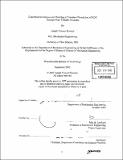Experimental analysis and modeling of transient dissolution of RDX through mass transfer processes
Author(s)
Romero, Joseph Vincent, 1977-
DownloadFull printable version (5.241Mb)
Other Contributors
Massachusetts Institute of Technology. Dept. of Mechanical Engineering.
Advisor
John H. Lienhard.
Terms of use
Metadata
Show full item recordAbstract
A simulation study was performed to model the transient behavior of the dissolution of hexahydro-1, 3,5-trinitro-1, 3,5-triazine (RDX) in Composition B. Composition B, also referred to as CompB. CompB is made up of three parts: 54% RDX, 6% HMX and 40% TNT. A numerical simulation was employed to model the overall solute transport equation. The solute transport equation takes into account advection, dispersion, sorption, degradation, mobile-immobile sorption, and a mass transfer source term. Numerical code was developed and this model simulated the following: (1) flow rate, (2) initial mass loading, (3) particle size and (4) field oil. The simulation model results verified laboratory experiments provided by Phelan et. al. [2003] by applying the governing advection-dispersion equation with a linear-driving-force source term of the form kf (C, - C) . The variable k represents the lumped mass transfer coefficient [1/day], which implicitly incorporates specific surface area. The concentration denoted as C [mg/L], represents the effluent chemical concentration present in water at a given time while C, [mg/L] represents the concentration at equilibrium. The mass transfer source term was evaluated by correlating k to the modified Sherwood number. The modified Sherwood number was fitted with a least-squares method that approximated non-aqueous phase liquid (NAPL) dissolution [Miller et. al., 1990]. This study adjusted the constants developed with the obtained modified Sherwood number to model RDX. Modeling development used a modified Sherwood number in the form: ... The simulation code effectively modeled RDX effluent profiles.
Description
Thesis (S.M.)--Massachusetts Institute of Technology, Dept. of Mechanical Engineering, 2003. Includes bibliographical references (leaves 79-80).
Date issued
2003Department
Massachusetts Institute of Technology. Department of Mechanical EngineeringPublisher
Massachusetts Institute of Technology
Keywords
Mechanical Engineering.